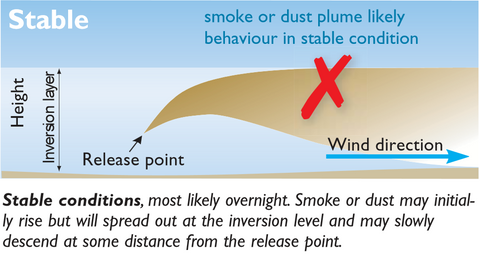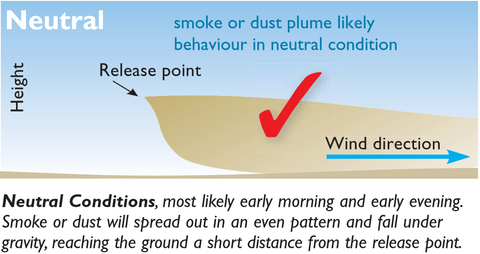Pesticide spraying and its effectiveness are extremely sensitive to atmospheric conditions, which is the reason why people in the agricultural field utilize Kestrel Delta T Meters. Due to the dangerous effect of chemical droplets drifting and being deposited in other fields/habitats/etc. from improper atmospheric conditions, there are specific criteria given by the Australian Bureau of Meteorology as to when it is safe for pesticide spraying. Read on to see what those guidelines are and learn why they're so crucial in agriculture.
Atmospheric Stability
Atmospheric stability is the measure of the atmosphere's tendency to resist or assist vertical motion of air. Stable atmospheres will keep air from moving up (thus carrying particles with it), while an unstable atmosphere will resist any vertical motion. A neutral atmosphere will do neither, and is the best for spraying because the droplets will neither get swept up by unstable air currents nor concentrated by stable atmospheres. Diagrams for each are shown below:
Thermal Drift
Thermal Drift is caused by an unstable atmosphere, and causes chemical droplets to be carried significant distances from the target area by thermal eddies. The measure of Delta T is increasingly being used by sprayers to measure spray conditions and prevent thermal drift.
Delta T
Delta T is the measure of evaporation rate and lifetime of a droplet. It is calculated by the dry bulb temperature minus the wet bulb temperature. A Delta T between 2 and 8 is ideal for spraying, and should never be higher than 10. Kestrel 3500 meters accurately measure Delta T for farming applications instantaneously.
Wind
Weather maps may be used to measure wind speeds over a given area, but be aware that wind at ground level can differ greatly from a weather map due to obstacles in the actual wind's path that redirect and deflect predicted wind flow. These winds can be very chaotic in speed and direction, so a live meter reading is always recommended. Also, wind can vary throughout the day, with the least wind early in the morning and the most during late morning/early afternoon. Spray when the wind is blowing away from sensitive areas. Ideal wind speed for spraying is between 3 and 15 km/h.
Temperature
Ideal spraying temperature is above 28°C. Typical meteorological temperature readings are taken in the shade, over 1 meter above the ground. The issue with this in regards to farming is that on a hot day, ground temperature may be 20°C or even higher. These high ground temperatures can cause volatile pesticides and herbicides to evaporate quickly and create a harmful vapor, even if the air temperature appears to be suitable. A live reading of the temperature is always recommended before a spray.
Humidity
Humidity has a great effect on evaporation rate; humidity above 45% is ideal for spraying. However, very high humidity can suppress evaporation, leading to an extended droplet lifetime and a greater chance for drift. Low humidity can cause rapid evaporation, which will also lead to drifting. A combination of low humidity and high temperature can even cause pesticides to crystallize and activate at a later time, throwing off the uptake timing of the pesticide.
These guidelines are only a high-level overview of the atmospheric criteria important to spraying. Having a deep understanding of humidity, Delta T, temperature, and drift in regards to your particular spraying locations can be critical in successful spray applications. The Kestrel 3500 meter was designed specifically for crop sprayers, and allows them to measure all of the aforementioned criteria and more. Keep in mind that in Australia, on-site weather condition readings are required before each spray. For more information about the Kestrel Delta T meter, click here. For more information regarding crop spraying best practices, please refer to one of the sources below:
Sources
"Weather for Pesticide Spraying" - Australian Government Bureau of Meteorology
"Spray Drift Management" - Primary Industries Standing Committee
"How to Prevent Spray Drift" - Queensland Government DPI publication
The University of Queensland
Nufarm
Grains Research and Development Group - GRDC






